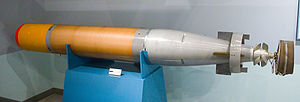| Mark 44 torpedo | |
|---|---|
 A Japanese built Mk44 torpedo at the Kanoya Air Base Museum, Japan | |
| Type | Antisubmarine torpedo[1] |
| Place of origin | United States |
| Service history | |
| In service | 1957-1967[1] (with United States Navy) |
| Used by | See Operators |
| Production history | |
| Designer | Naval Ordnance Test Station Pasadena[1] General Electric |
| Designed | 1953[1] |
| Manufacturer | General Electric[1] Naval Ordnance Station Forest Park American Machine and Foundry |
| Variants | Mark 44 Mod 1[1] |
| Specifications | |
| Mass | 432 pounds (196 kg) |
| Length | 8.2 feet (2.5 m) |
| Diameter | 12.75 inches (32.4 cm) |
| Muzzle velocity | 123 metres per second (400 ft/s) |
| Effective firing range | 123 metres (135 yd) |
| Warhead | Mk 101 Mod 0, HBX-3[1] |
| Warhead weight | 75 pounds (34 kg) |
Detonation mechanism | Mk 19 type Mod 12 contact exploder[1] |
| Engine | Electric[1] 30 horsepower (22 kW) |
Operational range | 3.4 miles (5.5 km) |
| Maximum depth | 1,000 yards (910 m) |
| Maximum speed | 30 knots (56 km/h; 35 mph) |
Guidance system | Helix search[1] |
Launch platform | Destroyers and aircraft[1] |
The Mark 44 torpedo is a now-obsolete air-launched and ship-launched lightweight torpedo manufactured in the United States, and under licence in Canada, France, Italy, Japan and the United Kingdom, with 10,500 being produced for U.S. service. It was superseded by the Mark 46 torpedo, beginning in the late 1960s. The Royal Australian Navy, however, continued to use it alongside its successor for a number of years, because the Mark 44 was thought to have superior performance in certain shallow-water conditions.
It has been deployed by many navies and air forces including the USN, Royal Navy, Royal Australian Navy and the Royal Air Force from various launch vehicles. These include long-range maritime patrol aircraft, e.g. P-3 Orion, RAF Nimrod, Canadair Argus, LAMPS and other embarked naval helicopters, ASROC missiles, Ikara missiles.